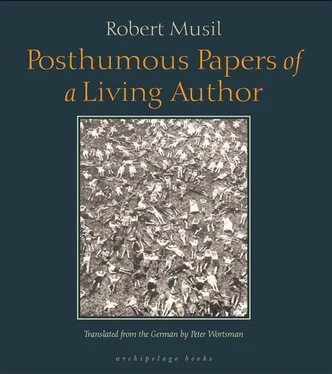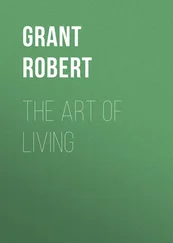When after a little while they’ve overcome the spiritual exhaustion and resume the fight for survival, they’re trapped in an unfavorable position and their movements become unnatural. Then they lie down with outstretched hindlegs, propped up on their elbows, and try to lift themselves. Or else seated on the ground, they rear up with outstretched arms like women who attempt in vain to wrest their hands free of a man’s fists. Or they lie on their belly, with head and arms in front of them as though fallen while running, and they only still hold up their face. But the enemy is always passive and wins at just such desperate, muddled moments. A nothing, an it draws them in: so slowly that one can hardly follow, and usually with an abrupt acceleration at the very end, when the last inner breakdown overcomes them. Then, all of a sudden, they let themselves fall, forward on their face, head over heels; or sideways with all legs collapsed; frequently also rolled on their side with their legs rowing to the rear. This is how they lie there. Like crashed planes with one wing reaching out into the air. Or like dead horses. Or with endless gesticulations of despair. Or like sleepers. Sometimes even the next day, one of them wakes up, gropes a while with one leg or flutters a wing. Sometimes such a movement sweeps over the lot, then all of them sink a little deeper into death. And only on the side, near their legsockets, is there some tiny wriggling organ that still lives a long time. It opens and closes, you can’t describe it without a magnifying glass, it looks like a miniscule human eye that ceaselessly opens and shuts.
Monkey Island
In the Villa Borghese in Rome, a tall tree stands without bark or branches. It is as bald as a skull, pealed clean by sun and water, and yellow as a skeleton. It stands erect without roots and is dead, and, like a mast, is implanted in the cement of an oval island the size of a small steamboat, and separated from the kingdom of Italy by a smooth, concrete-covered ditch. This ditch is just wide enough, and on the outer side, just deep enough, so that a monkey could neither climb through it nor jump over it. From the outside in, it could probably be done, but not the other way around.
The trunk in the middle offers very good grips, and as tourists like to say, is ideal for free and easy climbing. But up on top, long, firm branches grow out horizontally; and if you were to take off your shoes and socks and with inward-hugging heels, with your soles pressed fast to the rounded branch, and your hands grasping firmly, one in front of the other, you’d have no trouble reaching the end of one of these long, sun-soaked branches that stretch out over the green, ostrich-feathered peaks of the pines.
This wonderful island is settled by three families of varying size and number. About fifteen sinewy, nimble boys and girls, all about the size of a four-year-old child, inhabit the tree; while at the foot of the tree, in the only building on the island, a palace, the shape and size of a doghouse, a couple of far mightier monkeys live with a very small son. This is the island’s royal couple and the crown prince. Never do the old ones wander far from home; like watchmen, motionless, they sit to the right and left of him and stare down their snouts into the distance. Only once every hour the king rouses himself and mounts the tree for a perambulating look around. Slowly he then steps along the boughs, and it doesn’t seem that he cares to notice how reverentially and distrustfully everyone shrinks back, and — to avoid a stir — they slink over sideways till the end of the branch permits no further retreat, and nothing but a perilous leap down to the hard concrete is left. So the king strides the length of the boughs, one after the other, and the most acute attentiveness cannot decipher whether all the while his face evinces the discharge of a ruler’s duty or a survey of the grounds. Meanwhile, on the palace roof the crown prince sits alone, for astonishingly his mother also always departs at the same time, and through his thin, wide, stuck-out ears the sun shines coral-red. Seldom can one see a thing so dumb and pathetic, and yet so much encompassed by an invisible dignity, as this young monkey. One after the other, the tree monkeys, who were chased to the ground, file past him, and could easily twist off his skinny neck with a single grip: They’re in an awful mood, but they make a wide detour around him and display all the reverence and reserve that his family is due.
It takes a long time to notice that aside from these beings who live such a well-ordered life, still others inhabit the island. Driven from the surface and the air, a large population of little monkeys live in the ditch. If one of them even shows his face on the island above, he is chased by the tree monkeys back into the ditch, under severe reprisals. At feeding time the little ones must sit timidly to the side, and only when the others are full and mostly at rest up in the tree, are they permitted to sneak over to the crumbs. They’re not even allowed to touch what’s thrown to them. A nasty boy or a tricky girl are often just waiting for the chance. Though with a wink they may feign indigestion, they carefully slip down from their perch, as soon as they notice that the little ones are having too good a time. Those few who dared climb up onto the island are already scurrying screaming back into the ditch; and they mingle with the others; and the howling outcry begins. And now they all press together, so that a single surface of hair and flesh and mad, dark eyes well up against the outer wall like water in a tipped-over tub. The persecutor, however, only walks along the edge and shoves the wave of shuddering terror back away from himself. Thereupon the little black faces stir. They throw up their arms and stretch out their palms in supplication before the evil foreign eye that gazes down from the edge. And soon this gaze attaches itself to one individual; he shoves backwards and forwards, and five others do it with him, who can’t yet make out which one of them is the target of this long look; but the weak, fear-crippled mass of monkeys does not budge. Then the long, indifferent gaze nails its arbitrary victim; and at last it’s completely impossible to control oneself any longer, not to show either too much or too little fear: And from one moment to the next the lapse of self-control swells, while one soul digs into another till the hate is there, and the crack gives way, and without shame or poise a creature whines under torture. With the release of a scream, the others rush apart on down the ditch; they flicker dimly about like the damned souls in the flames of purgatory, and gather chattering cheerfully as far from the scene as possible.
When it’s all over with, the persecutor climbs with a feathery grip up the big tree to its highest branch, strides out to the very end of the branch, peacefully seats himself, and serious, erect, and ever so long, he stays like that without rousing. The beam of his glance glides over the Pincio and Villa Borghese; and where it leaves the gardens behind, there beneath it lies the great yellow city, over which, still swathed in the green shimmering cloud of the treetop, it floats, oblivious to all, suspended in midair.
Fishermen on the Baltic
On the beach they’ve dug out a little pit with their hands, and from a sack of black earth they’re pouring in fat earthworms; the loose black earth and the mass of worms make for an obscure, moldy, enticing ugliness in the clean white sand. Beside this a very tidy looking wooden chest is placed. It looks like a long, not particularly wide drawer or counting board, and is full of clean yarn; and on the other side of the pit another such, but empty, drawer is placed.
The hundred hooks attached to the yarn in the one drawer are neatly arranged on the end of a small iron pole and are now being unfastened one after the other and laid in the empty drawer, the bottom of which is filled with nothing but clean wet sand. A very tidy operation. In the meantime, however, four long, lean and strong hands oversee the process as carefully as nurses to make sure that each hook gets a worm.
Читать дальше











